If you’re reading this, there’s a good chance you believe your business might be suffering from outdated accounts payable processes.
Goldman Sachs says there’s a good chance you’re right. They recently estimated businesses in North America spend $187 billion per year on payment processing costs, with small businesses sacrificing $22 to pay a single invoice with a paper check. And that financial toll doesn’t take into account data entry errors, security risks and timeline inefficiencies associated with manual systems that rely primarily on paper.
There’s also a good chance that AP automation solutions could provide relief to better position your finance team to contribute to the company’s overall success, but you’re not quite sure how to begin evaluating whether automation is right for your business.
Here are five key questions you should ask as you consider automating your AP processes.
1. Is AP automation a good fit based on volume and company status?
Start off with a couple informative factors about where your company is, or may soon be, from a more macro perspective.
- Transaction Volumes: It takes a significant amount of time and energy to process a single invoice or payment in a predominantly manual system. If you have less than 100 invoices or payments per month you may be able to keep your head above water. But right on the other side of that century mark is where we typically start to see errors and inefficiencies in the process more consistently.
- Company Status: If your business is humming along at a consistent speed, you may feel ok with keeping the status quo. If your business is fortunate to be in scale-up mode, you’re likely debating whether you need to expand your accounting department to handle the mounting workload or find a way to free your people from so much manual data entry to put their time to more strategic use.
2. Will AP automation change the accounting processes we currently have in place?
Procedural inefficiencies led you to this point, but you don’t want to waste your time exploring solutions that won’t fix your problems, or worse yet, implementing something that will cause new ones.
Therefore, it’s extremely important to map out the processes you currently have in place so you can identify exactly what inefficiencies exist, and what causes them, in order to determine if automating can properly address them. You also need to understand what parts of the process are sacred to you and how an automation solution may impact your visibility and control.
Manually processing invoices and payments requires many steps – including opening mail, routing invoices, coding line items, seeking approvals, entering data, cutting checks, applying postage and mailing payments. All these steps are costing your business time and money.
The right automation tool should ease your workload and streamline processes by taking over the tasks you’d rather not do – like manual data entry, filing paper invoices, stuffing envelopes and mailing checks – while keeping control over routing and approvals in your hands. Ideally, all you’d have to do is code, approve and select for payment.

3. What is the true cost of our current AP process?
Everyone wants to know the potential return on investment (ROI) from a new solution, as they should. But don’t forget that the cost of your current system is an equally important factor in that ROI equation.
Hard costs from tangible items like stamps, envelopes and checks might seem inconsequential in isolation, but combined as a recurring expense in high volumes they can add up to a significant spend.
There are also soft costs to consider in accounts payable. After all, you are paying your employees for their time, so much of which is tied up in tedious tasks to manually process and execute payments. Consider the value to be gained if the time for which those people are being paid could be spent on more strategic and impactful business objectives.
4. How will AP automation work with our current accounting system?
For many financial professionals, this may be the most important question of all, with the accounting or enterprise resource planning (ERP) system often viewed as the business’s bible.
The short answer is that an automation solution worth your time should be able to integrate with your current accounting system rather than force a migration to a new central platform.
Most automated AP systems can work in tandem with your central ERP, making the system you already rely upon the system of record, through API or file-based integrations. Both file-based and automated versions require compatibility with your accounting system so that processes are seamless, happening in just a matter of a few seconds.
Not every automation provider integrates with every ERP, though, so confirm that alignment up front to save yourself time vetting a solution you can’t implement.
5. How does the implementation process work?
Assessing the value and benefits of automation in a vacuum is only a partial view of the bigger picture. You need to think about how and when a solution will come to life for your company.
How long will it take to complete the onboarding process? What’s involved in that process, and what kind of support can you expect once you are up and running?
Automating your invoice and payment process is not as expansive as you may think. While implementing a new accounting system may take six to 18 months to complete, AP automation can happen in 30 to 45 days, with flexibility to fit your needs and comfort level. Many companies do it in one shot, while some decide to automate their processes over short time intervals.
With “software as a service” (SaaS) providers, like AvidXchange, you will have a team of dedicated experts working directly with your team through implementation and a support staff on-hand to help you work through any issues down the road.
Adding Automation to Your Future Planning
You already recognized the potential for technology to improve efficiency in your company’s financial operations, and now you’re armed with several factors to consider if AP automation should be part of your future plans. If you’re ready to dig deeper into automating your AP processes, schedule a demo with AvidXchange today.



